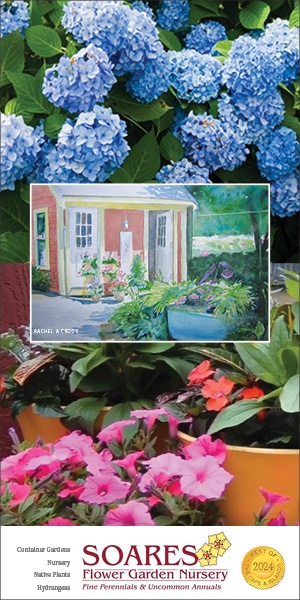
Artist Profile: Salvatore & Romolo Del Deo
Cape Cod Art / Annual Art 2016 / Art & Entertainment, People & Businesses
Writer: Amanda Wastrom
Artist Profile: Salvatore & Romolo Del Deo

Cape Cod Art / Annual Art 2016 / Art & Entertainment, People & Businesses
Writer: Amanda Wastrom

“Terra, Acqua, Fuoco” bronze edition, 50″ x 24″ x 24″
In the East End of Provincetown, there is a dirt road that begins with a smattering of mismatched mailboxes stabbing the ground at all angles and looking as if they might tip over in the next big rainstorm. The mailboxes show no sign of the cauldron of creative art making that is bubbling at the road’s other end. The road leads to the houses and studios of two generations of Provincetown artists, Salvatore and Romolo Del Deo, father and son, respectively. Each man embodies the artistic life that is alive and well in the century-old art colony at the tip of Cape Cod.
“My father (at almost 88) says that now he is officially the oldest living artist in Provincetown,” says Romolo. “I’m part of a living tradition here.” Romolo recalls growing up in a rich environment of art and politics. “Pretty much all the adults I knew were artists, writers, political activists, musicians,” he says. “It was like this movable feast that went through our house with people coming to dinner and meetings.”
Superficially, the Del Deos could not be more different in their work. Perhaps the only formal similarity is an affinity for the human figure, a key motif in both artists’ oeuvres. However, they are of one mind when it comes to process, and their beliefs about art. They share a love of experimentation, a distrust of perfection, and a commitment to artistic integrity, regardless of commercial viability. “The last thing we think about is the commercial success of the thing,” says Sal.
Originally trained as a stone carver, Romolo creates languid, romantic, figurative sculptures in bronze. He appropriates the forms and motifs of classical sculpture and translates them into his own contemporary language. The pieces appear crumbled and broken, as if excavated from ancient Roman ruins. “I was fascinated when I was a student with archaeological digs,” says Romolo. “I liked things that weren’t perfect, that had pieces broken off. When things aren’t perfect, there is the possibility for poetry to enter in.”

“Yellow Sky”, oil on canvas, 20″ x 30″
Sal is known for his vivid oil paintings and watercolors. Provincetown is his enduring subject—sometimes explicitly, sometimes implicitly—whether through landscape, seascape, narrative, or portrait.
After six decades as a professional artist, he is all about paring the process down to its essentials. “What I’d like to eventually do is create a painting that veers as far away as possible from recognition,” Sal says. “In other words, it could be close to non-objective, yet there is something still organically recognizable. I’m paraphrasing what [Jean-Baptiste-Camille] Corot said. I wish I could remember the quote, but in paint, you leave out things until you come to the essence of the thing you are painting.”
Sal came to Provincetown for the first time in the 1940s when he was 17 to study painting. Despite having grown up in Providence, R.I., he had never even heard of Provincetown or Cape Cod. He took one look at the sunlit piles of sand surrounded by ocean and decided he would live there one day. For years Sal spent summers in Provincetown under the tutelage of Henry Hensche and winters at the Vesper George School of Art in Boston and Art Students League in New York, where he studied with famed Cape painter Edwin Dickinson, who became a major influence on him.
By the end of the 1950s, he had met his wife, Josephine, and settled permanently in a tiny cabin in the woods, at the end of a gravel road. Making a life as an artist was easier then, says Sal. “You could rent an entire studio for $75 for the year.”
Josephine and Sal were instrumental in founding the Fine Arts Work Center, a residency program for artists and writers. During the past 40 years, the program has drawn a small but steady stream of artists who have made Provincetown their home.
After a childhood immersed in P-town’s art world, Romolo left home at 18 to apprentice in stone carving workshops in Italy. He spent the next 20 years traveling back and forth between Europe and the U.S., attending Harvard University, and building his practice and life in New York City. Years spent working in a foundry allowed him the freedom to experiment with bronze. “I just cast whatever and tried new things,” he says. “Working in a foundry, you’re not isolated from the disasters. One of the greatest tools an artist has is looking at what went wrong. If you focus only on your goal, you may miss possibilities that you weren’t expecting. It’s that whole idea of serendipity that artists really need.”
In 2011 Romolo returned to his hometown. Recently he has been mixing sand into his bronze castings, which creates volatility in the process and adds a distinctive patina to the finished bronze. Sand also represents an important connection to place. “I never really thought of myself as a Cape Cod artist. I occasionally showed here, but the work was never about here,” he explains. “Sand entering my work seemed like the perfect analogy for returning to my hometown. Anybody who’s from Cape Cod can relate to the idea of how sand permeates everything here. It gets everywhere!” – Amanda Wastrom
Salvatore and Romolo Del Deo are represented by Berta Walker Gallery,
208 Bradford Street, #1, Provincetown. Romolo Del Deo’s website is studioromolo.com.



